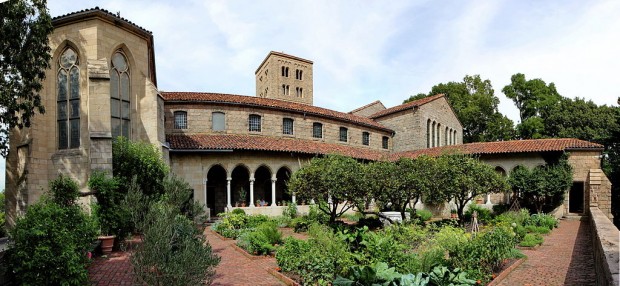On the elevated ground of Fort Tryon Park, in a wooded glade overlooking the uniformity of Hudson Height’s brownstones and ’70s highrises, stands a startling incongruity—a monastery, apprently fresh out of the Middle Ages. And much of it actually is. Part of the building is the work of Gothic revivalist Charles Collens, but the rest is actual stone from five different European abbeys, reassembled to house one of the world’s most impressive medieval art collections. It’s The Cloisters, an extension of the Metropolitan Museum of Art, which got its start as the personal collection of John D. Rockefeller (who also, incidentally, created the park).
You come near the Cloisters by winding roads or footpaths, approaching the past obliquely. Despite its towering size the entrance is merely a small door at the base of a wall. The long staircase that follows takes you past a series of 1930s photographs, snapshots of the Cloisters caught at progressively increasing stages of construction. The ticket booth is found at the summit of the stairs, where, as with the Met, you’ll find that the $25 requested donation is exactly that—you can pay as much or as little as you desire, and there’s no shame in seeing the 15th century for a nickel.
The Cloisters features a marriage of gallery and art that exceeds almost anything else you’ll find. The wooden statues of saints look like they belong in the bare stone rooms, and much of medieval art was integrated into the architecture—in one gallery, the ceiling numbers among the works of art it contains. Given the era and the name of the museum, it’s unsurprising that most of the art is religious in nature. One of the most impressive works is a wooden rosary bead that opens to reveal an impossibly tiny diorama of the life of Jesus. Chapel furniture and statuary make up much of the collection. There’s a lectern in the shape of an eagle subduing a dragon, and seats for clerics that flip up to reveal carved grotesques. Among the most famous of the museum’s holdings is the Mérode Altarpiece by Robert Campin, a three-panel depiction of the Annunciation considered by many to be the greatest Early Netherlandish work in New York. At the Cloisters you can see it unimpeded by intervening glass—don’t get too close, though, or the protective sensors will beep at you.
Many of the works actually are architectural elements, many of which are found in Gallery 3, which houses the cloister from Saint-Guilhem-le-Désert, and in the central abbey garden. Capitals and cornices decorated with romping animals and rude figures tugging at each other’s beards display the humorous side of the medieval religious experience, while the tranquility of the garden with its historic plants and bubbling fountain reveal its deep peace. And there are secular works, too—the Cloisters is home to a vast collection of manuscripts from the era, as well as the famous Unicorn Tapestries, a series of stunning textile works that tell the story of the hunt and capture of the elusive beast.
The museum can be found at 99 Margaret Corbin Drive, Fort Tryon Park, New York, NY 10040.






































No Comments